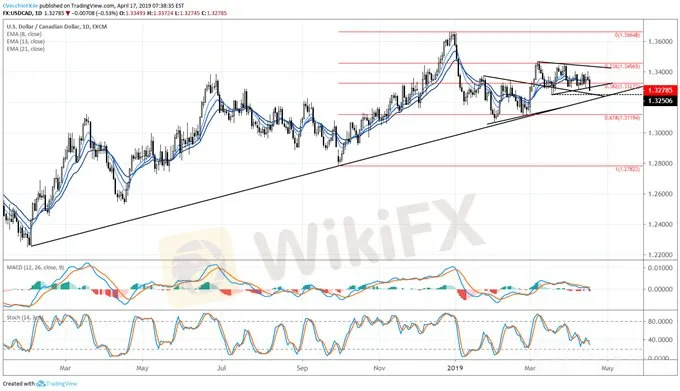简体中文
繁體中文
English
Pусский
日本語
ภาษาไทย
Tiếng Việt
Bahasa Indonesia
Español
हिन्दी
Filippiiniläinen
Français
Deutsch
Português
Türkçe
한국어
العربية
US Dollar Technicals Weaken; USDCAD Exits Symmetrical Triangle
Abstract:The commodity currencies are showing increasing strength in recent days, in line with global equity markets continuing their surge higher.
The US Dollar (via the DXY Index) is showing signs of technical stress once again, with price action thus far on Wednesday shaping into a bearish outside engulfing bar – typically an indication that more downside may be forthcoming. While theres still a long day ahead before the candle closes out, much of the economic data released during the Asian and European sessions should help relieve concerns over a near-term global slowdown – which in turn, reduces demand for the safe haven currencies like the Japanese Yen and US Dollar.
Chinese Economic Data Offers Relief
The commodity currencies have been riding high the past few days, largely following the uptick in global equity markets. But data out of China overnight has provided another reason for traders to be optimistic that the global economy didn‘t slow down significantly at the start of 2019. Q1’19 Chinese growth came in at 6.4% annualized, slightly higher than the 6.3% estimate provided by Bloomberg News. Strong retail sales and better industrial production figures undergirded the better growth figure
March Canada Inflation Rebounds
With oil prices rebounding significantly over the past several months, there was little doubt that Canadian inflation figures would return back to the topside. Coming it at 1.9% from 1.5% (y/y), headline inflation is back near the Bank of Canada‘s medium-term target of 2%. Rate expectations have responded in turn by pricing out the odds of a rate move in the first half of 2019: there’s only a 1.4% chance of a 25-bps cut before the end of June.
USDCAD Technical Forecast: Daily Price Chart (December 2017 to April 2019) (Chart 1)

A clear lack of follow through to the topside in USDCAD following the breakout from the early-2019 symmetrical triangle resulted in another symmetrical triangle. The recent iteration saw USDCAD price consolidating since early-March, trading between the 23.6% and 38.2% retracements of the Q418 high/low range; the symmetrical triangle from January to early-March consolidated between the 38.2% and 61.8% retracements.
But following todays Canada inflation data, the symmetrical triangle since the start of March has broken to the downside. Near-term levels of interest are the April low at 1.3284 and the March low at 1.3251 (concurrently where the rising trendline from the February 2018, October 2018, and March 2019 lows intersects next week).
DXY Index Technical Forecast: Daily Price Chart (March 2018 to April 2019) (Chart 2)

Momentum remains weak for the DXY Index, particularly as a bearish outside engulfing bar takes shape. As such, there still is potential for more downside – price is below its daily 8-, 13-, and 21-EMA envelope while both daily MACD and Slow Stochastics have turned lower (the former is in bullish territory still, while the latter is now in bearish territory). Better opportunities still exist in the JPY-crosses (like AUDJPY and EURJPY) in the immediate near-term.
Disclaimer:
The views in this article only represent the author's personal views, and do not constitute investment advice on this platform. This platform does not guarantee the accuracy, completeness and timeliness of the information in the article, and will not be liable for any loss caused by the use of or reliance on the information in the article.
Read more

Forex Economic Calendar Week Ahead: Fed Meeting, New Zealand GDP, Australia Jobs & More
Three central bank meetings are on the calendar over the coming week, including the Federal Reserve and the Bank of Japan.

FX Week Ahead - Top 5 Events: August Canada Inflation Report & USD/CAD Rate Forecast
The August Canada inflation report (consumer price index) is due on Wednesday, September 18 at 12:30 GMT.

US Dollar Reversal Continues: EUR/USD, GBP/USD, USD/CAD
The US Dollar came into the holiday-shortened week with a full head of steam. But that's been soundly reversed. Tomorrow brings NFP and Canadian employment.

USDCAD Forecast: RSI Snaps Bullish Formation Following BoC Meeting
Recent developments in the Relative Strength Index (RSI) foreshadow a further decline in USDCAD as the indicator snaps the bullish formation carried over from July.
WikiFX Broker
Latest News
BI Apprehends Japanese Scam Leader in Manila
Bitcoin in 2025: The Opportunities and Challenges Ahead
Join the Event & Level Up Your Forex Journey
Is There Still Opportunity as Gold Reaches 4-Week High?
Bitcoin miner\s claim to recover £600m in Newport tip thrown out
Good News Malaysia: Ready for 5% GDP Growth in 2025!
FXCL Lucky Winter Festival Begins
Warning Against MarketsVox
Is the stronger dollar a threat to oil prices?
Rising Risk of Japan Intervening in the Yen's Exchange Rate
Currency Calculator






